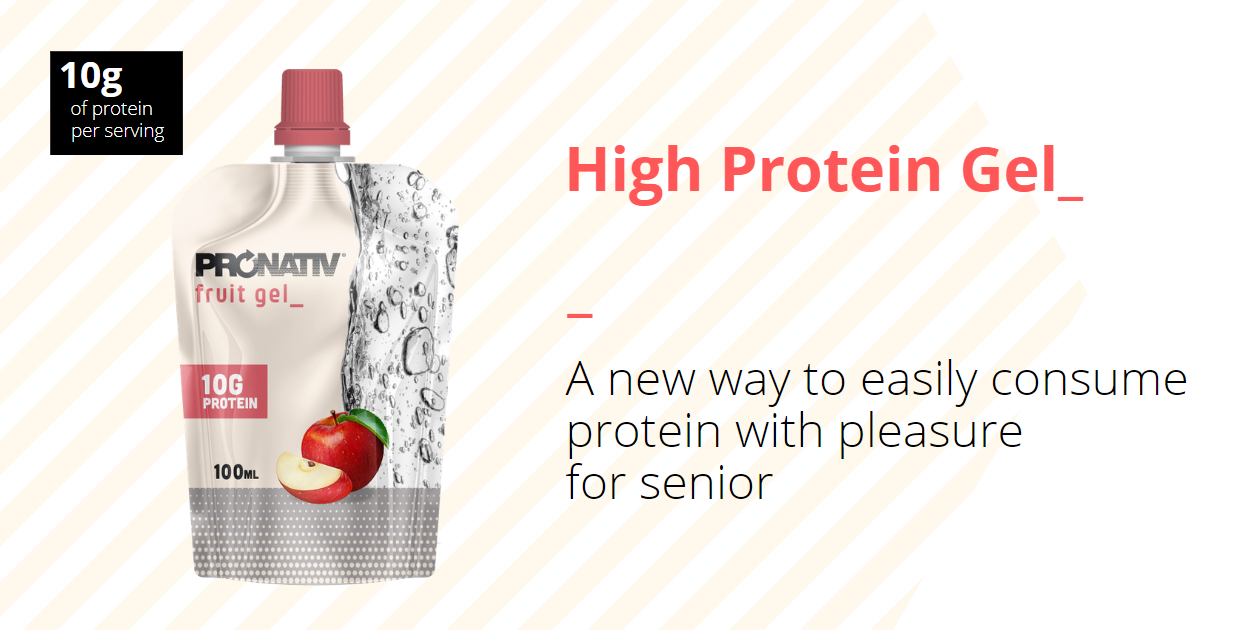
Meet the Growing Demand for Healthy Ageing with Innovative, High-Protein Products
Living longer, living better:
Our world is living longer, lifespans are increasing. According to the United Nations, one in six people will be over age 65 by 2050 [1]. The “senior” category is often assigned to people of retirement age who may be “slowing down” or suffering from health problems”. Ageing depends on several factors: intrinsic factors depending on people’s background, and also environmental and social factors: sex, education level, community, standard of living. Each person grows older differently, there is no stereotype for ageing.
As the age of retirement is delayed, adults stay longer in the workforce, it implies staying active longer. It is also observed that people are now better informed, and more implicated on their health than previous generations. Healthy ageing is defined as senior abilities to maintain basic needs, learn, make decision, stay mobile, maintain and build relationships, and contribute to society [2]. It is a new topic for the coming years. People concerned by healthy ageing are not only “old” people, but also younger individual who wants to maintain their health. Staying proactive is part of a healthy lifestyle. That is why it is important to offer solutions for this new category of people.
The proactive approach to ageing creates markets for a new type of senior-focused products. Consumers tend to prevent, rather than wait for issues. Senior nutrition is moving from cure to prevention. People tend to turn to nutritional solutions to preserve themselves as long as possible. It is an opportunity for food and drink manufacturers to innovate on new formulations that provide energy and benefits for health.
Healthy ageing, an opportunity for the industry:
Nowadays, there is a growing interest for products that could slow down the ageing process. Nutrition can be used as prevention with positive ageing claims. Relevant health concerns about ageing are the loss of functional abilities, and cognitive health. Maintaining a healthy lifestyle and a nutrition approach are two ways of prevention against it. Nutrient supplements exist to prevent age related cognitive decline (fatty acids (omega 3), choline, calcium, proteins…). Claims for senior products on the market target mostly muscles, bones, gut, skin, eyes, heart immune system and cognitive health. [3].
More specifically, interest for high protein products for seniors has increased between 2014 and 2018 [3]. The claims associated with products recently launched on the senior market meet the demand for preserving joint and muscle health. The dairy category offers a large range of high protein added products. The Asian market is particularly dynamic in terms of launches and can provide opportunities for dairy manufacturers [3]. This observation is mostly explained by a significant growing of ageing population in China.
To get the best benefits on muscular functions, it is necessary to consider the quality of protein determined by leucine rate and amino acid profile.
Protein intake for muscles preservation:
Nowadays, elderly people are more conscious about preserving their health: 59% of US consumers over age 65 are focused on getting more exercise [4]. Exercising can prevent sarcopenia but is not always enough. Sarcopenia is part of the ageing process, it is a loss of muscle mass and strength which affects mobility. This phenomenon, is the consequence of a decrease in proteosynthesis, and a rise in proteolysis and affects 25% of 65+ years old [5]. The process can be slowed down by physical activity and by a nutritional approach.
Increased protein and amino acid supplementation can play a role in slowing down the process. Providing food with a good source of protein is important for muscle synthesis. The aim is to bring sufficient quantity of high quality proteins and to balance the distribution throughout the day. According to the International Osteoporosis Foundation, older adults may need more dietary protein per kilogram than their younger counterparts, to maintain functionalities and support good health [6]. The daily intake recommended is “at least in the range of 1.0 to 1.2g protein per kilogram of body weight per day” [7]. To stimulate proteosynthesis in the muscles, a sufficient amount of protein must be ingested during a meal (25 – 30 g proteins/meal) [8]. In that context, high-protein food and drink supplement can help to get the necessary amount of proteins.
To get the best benefits on muscular functions, it is necessary to consider the quality of protein determined by leucine rate and amino acid profile. Whey proteins are effective for seniors to rebuild muscles loss thanks to their richness in leucine. Studies prove that consumption of milk proteins has benefits on bones. A study on seniors (average of 85 years), shows that consumption of milk proteins has a positive impact on bone’s mechanical resistance [9].
Ageing also affects the sensory perception, taste, olfaction, sense of touch, vision and can be gradually accompanied by a loss of appetite. That is why it is ideal to offer something (food or beverage) appetizing, attractive, and high in protein. There are opportunities for food and drinks manufacturers to design products with such characteristics for seniors: nutrition formulations, easy to consume, practical and flavorful, preventing related health concerns.
To meet the needs of senior consumers in terms of muscle health, Lactalis Ingredients has thought about a new way to integrate and consume protein through a High protein fruit gel.
A protein shot to fulfill the needs of health-conscious seniors:
The negative protein balance results in higher protein needs for seniors, to avoid muscle loss. Leucine is a key amino acid required to initiate protein synthesis in muscle. Quality of proteins is determinant. To meet the needs of senior consumers in terms of muscle health, Lactalis Ingredients has thought about a new way to integrate and consume protein through a High protein fruit gel. The goal is to offer a low-volume with a high level of protein that is easy to swallow, appetizing and tasty. Older people are also sensitive to the practicality of products. Hence the importance is to think about an easy to open and easy-grip pack.

This prototype has a pleasant soft texture, and can be declined in different flavors. The gel texture is adaptable according to the consumers targeted. It is currently imagined in a pouch, a nice format to be swallowed, but it could be adapted in any spoonable product. The shot, formulated with our native whey protein Pronativ®, is designed to be a supplement after a meal, to bring the sufficient amount of protein recommended, and to potentiate protein synthesis from the total protein intake during the meal. According to a published report from Lactalis Ingredients, 8g of Pronativ® bring the necessary leucine content [10]. We suggest to incorporate a dose between 10-12g to take into consideration the difference in seniors needs.
Pronativ®, a high quality native protein:
Lactalis Ingredients as whey protein manufacturer made this concept with 10 % of high quality native whey protein Pronativ®. Pronativ® is a native and natural whey protein interesting to develop nutrition supplement for elderly people. It is extracted from a soft process which maintains its high quality protein composition. The ingredient is known and recognized for its valuable amino acid, and nutritional profile.
Pronativ® is ideal to be incorporated in such products. Its high leucine rate (15% more leucine than a standard WPC/WPI from whey) is ideal to meet the needs of seniors worried to preserve their muscles from ageing process. Furthermore, Pronativ® can be incorporated in lot of other applications such as bars, cakes, drinks…
Due to the emergence of a new category of consumers, and the growing demand to preserve body functions, there are tremendous possibilities for the industry to develop claimed products related to seniors. In this context, the protein enriched products are an interesting segment for all kinds of innovations to answer various needs.
Sources:
[1] The United Nations,. (s.d.). “Ageing”. Retrieved on www.un.org consulted on February 21th 2020
[2] The World Health Organization. (s.d.). “Healthy Ageing”. Retrieved on www.who.int consulted on February 21 th 2020
[3] Global New Products Database. (s.d.). Mintel GNPD. Consulted on February 24th 2020
[4] Seniors Health US. (2016, December). Mintel trend consulted on February 25th 2020
[5] I. Janssen, S. H. (2002). “Low relative skeletal muscle mass (sarcopenia) in older persons is associated with functionnal impairment and physical disability”.
[6] International Osteoporosis Foundation,. (s.d.). Preventing Sarcopenia. Retrieved on www.iofbonehealth.org consulted on February 26 th 2020
[7] Bauer et al. . (August 2013). “Evidence based Recommendations for Optimal Dietary Protein Intake on Older people : a Position Paper from the PROT-AGE stydy groupe”.
[8] Douglas Paddon-Jones. Rasmussen, D. (2010). “Dietary Protein recommendations and the prevention of sarcopenia protein, amino acid metabolism and therapy”.
[9] Langsetmo. ( 2018). “High Dairy protein intake is associated with greater bone strenght parameters at the distal radius and tibia in older men: a cross sectionnal study”.
[10] Nutrition and ageing,. (2015). “Effect of supplementing meals with soluble milk proteins on plasma”.















